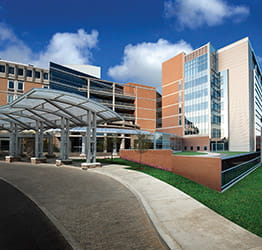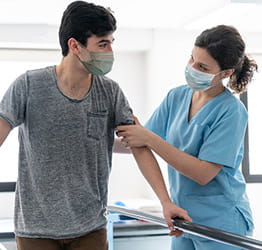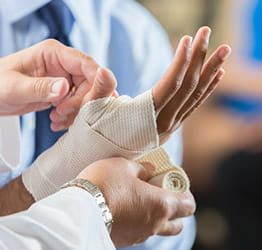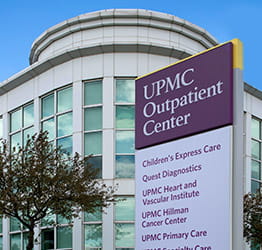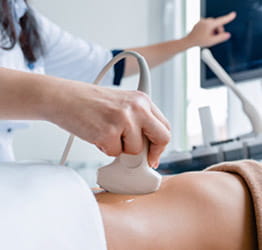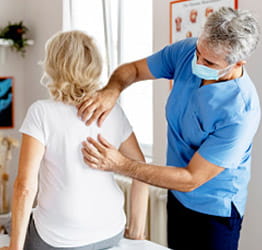Essential tremor is a neurological disorder that causes involuntary shaking in the body. The shaking (tremors) can range from mild to severe, potentially affecting a person's ability to perform daily activities.
The specific cause of essential tremor is not known. It can appear at any age but is mainly found in people over age 65.
Potential treatments for essential tremor include medication, deep brain stimulation, focused ultrasound, and Gamma Knife® radiosurgery.
Looking for Essential Tremor Care?
On this page:
What Is Essential Tremor?
Doctors define essential tremor as a neurological disorder that causes involuntary shaking in one or more areas of the body. More specifically, essential tremor is a movement disorder, meaning it affects parts of the brain that control body movement or motor function.
Tremors are very rapid, generally more than five times a second. The shaking can occur in the hands, arms, head, voice, or other muscles. It rarely occurs in the lower extremities. The tremor may be mild initially but can worsen over time.
In some cases, the tremor may be severe enough to interfere with:
- Eating or drinking.
- Speaking.
- Writing.
Essential tremor is not dangerous or life-threatening, but many people find it annoying and embarrassing.
What causes essential tremor?
The cause of essential tremor is unknown.
Research shows a link between essential tremor and degeneration of the cerebellum, an area of the brain in the back of the head. The cerebellum has several functions, including controlling voluntary muscle movements.
Essential tremor is often inherited. An inherited case of essential tremor is known as familial tremor.
Because many cases of essential tremor are inherited, genetics may be one factor in how the condition develops. However, essential tremor can also occur in people with no family history.
Essential tremor can occur at any age, including during childhood. But it is more common in older adults and tends to become more pronounced with age.
Back to Top
What are essential tremor risk factors and complications?
Essential tremor risk factors
Your risk of essential tremor can be higher based on:
- Age — Essential tremor is most prevalent in people over age 65.
- Family history — Research shows at least half of essential tremor cases are inherited. Familial tremor is a dominant trait, so you only have to inherit an altered gene from one parent.
Researchers have also focused on other risk factors, including sex, race, ethnicity, and lifestyle factors. To date, nothing is conclusive.
Complications of external tremor
Essential tremor is not life-threatening, but the tremors can cause problems with daily activities. For example, you may have trouble holding a pencil or pen and writing your name. Your voice may be shaky when you speak. Or you may find eating and drinking difficult.
The symptoms of essential tremor may worsen over time and cause an even greater impact on your daily life.
How common is essential tremor?
Essential tremor is the most common type of tremor, affecting about 7 million people in the U.S.
What Are the Signs and Symptoms of Essential Tremor?
The involuntary shaking of essential tremor generally involves small, rapid motions that occur more than five times per second.
The tremor is typically more noticeable when people perform actions like writing, eating, or drinking, and is less noticeable when people are at rest. Triggers like caffeine, stress, or fatigue can make tremors worse.
Essential tremor is most commonly noticed in the hands, but it may also affect your:
- Arms
- Eyelids
- Head
- Other muscles
Essential tremor in the legs and feet is very rare. The tremors may also not affect both sides of your body in the same way.
Emotional and behavioral impacts are possible because of essential tremor. Your symptoms may cause you to feel anxious, frustrated, angry, and more.
When should I see a doctor about my essential tremor symptoms?
Many people experience tremors at various times, but you should see a doctor if:
- You experience frequent, rapid tremors.
- Your symptoms are getting worse.
- Your symptoms interfere with your ability to perform daily activities.
- Your tremors are causing you emotional distress.
Contact your primary care provider (PCP), who can refer you to a neurologist for evaluation and diagnosis.
Back to Top
How Do You Diagnose Essential Tremor?
If you have symptoms of essential tremor, neurologists can evaluate your symptoms and provide a diagnosis.
To diagnose essential tremor, your doctor will ask for your medical history. They also will perform a physical exam, looking for specific essential tremor symptoms.
These symptoms may include:
- Head nodding or moving from side to side.
- Problems holding or using small objects, such as pencils or cups.
- Shaking or quivering voice.
- Tremors during movement that go away when you rest.
- Worse tremors after taking medications, caffeine, or during stressful times.
- Worse tremors as you age.
They may ask you to perform tasks like holding your arms in front of you, writing your name, or drawing a spiral.
Tests to diagnose essential tremor
There are no medical tests beyond a physical or neurological exam to diagnose essential tremor. In general, essential tremor does not affect coordination or mental function. Blood tests and imaging studies, such as MRI and CT scans, usually show no problems.
Based on your medical history, your doctor may order tests to rule out other conditions that could be causing your tremors. These tests could include thyroid testing, kidney and liver function tests, or screenings for toxins.
Essential tremor prognosis
Essential tremor is not life-threatening and the severity depends on the person. Some people experience only mild tremors while others have tremors that worsen as they age. In some cases, tremors can affect your ability to perform daily tasks or may be annoying or frustrating.
If you have mild symptoms, you may not need or want treatment. However, nonsurgical and surgical treatments are available.
Back to Top
How Do You Treat Essential Tremor?
Although there is no cure for essential tremor, treatment can help relieve symptoms and improve your quality of life.
Treatment options depend on:
- How severe your symptoms are.
- Your overall condition.
You may not need essential tremor treatment unless your tremors and their symptoms interfere with your daily life or cause embarrassment.
Experts at UPMC offer many state-of-the-art treatments to alleviate the symptoms of movement disorders and allow people to lead fuller and more independent lives.
Lifestyle changes
Avoiding triggers such as fatigue, caffeine, or stress may help you control your symptoms. Avoid foods and drinks with caffeine, get enough rest, and talk to your doctor about stress-management techniques.
If your symptoms are making it hard to perform daily activities, occupational and/or physical therapy may help. You also could consider adaptive devices like weighted utensils, wrist weights, and Velcro™️clothes fasteners.
Medicine to treat essential tremor
Medications commonly used to alleviate essential tremors include:
- Antiseizure medication.
- Beta blockers.
- Calcium-channel blockers (to reduce blood pressure).
- Mild tranquilizers.
Your doctors will work closely with you to monitor your response to medication and any side effects.
If a medication is triggering your symptoms, talk to your doctor about changing your dosage or switching to a new medication.
Deep brain stimulation for essential tremor
UPMC is a leader in treating movement disorders such as essential tremor with deep brain stimulation (DBS). We offer both standard and MRI-guided asleep DBS, depending on your condition.
Deep brain stimulation delivers electrical stimulation to targeted areas in the brain that control movement. This stimulation blocks the brain signals that cause abnormal movement.
DBS provides significant benefits in 80% to 90% of people who undergo the procedure for essential tremor.
What happens during deep brain stimulation?
DBS is a surgical procedure that lasts several hours and requires a short hospital stay.
It involves the following:
- A neurosurgeon implants a thin wire called an electrode into the area of the brain responsible for abnormal movement.
- The electrode is connected to a pulse generator, which is implanted under your skin near your collarbone.
- The pulse generator is activated and delivers mild electrical pulses through the wire to your brain.
- The pulses change your brain's electrical signals, helping to control or stop your tremors.
- The pulse generator can be adapted over time to change the amount of pulses delivered to your brain.
Focused ultrasound for essential tremor
Focused ultrasound is a nonsurgical, noninvasive procedure for essential tremor that combines ultrasound and MRI technology. About 30 to 40 high-intensity, targeted ultrasound beams ablate (burn) the area of your brain that is causing abnormal movement. The ablation creates a permanent lesion and helps to improve your symptoms.
You can have focused ultrasound performed on one or both sides of your brain. People who undergo focused ultrasound may notice improvements in their symptoms during the procedure. It may help improve symptoms by up to 80%, but it is not a permanent solution.
What happens during focused ultrasound?
Focused ultrasound involves:
- The focused ultrasound team shaves your head and attaches a frame and a crown-like device that contains ultrasound transmitters. The transmitters allow the neurosurgeon to see inside your brain and deliver the ultrasound beams to your brain.
- You are taken to an MRI machine, where you lie down on a table that slides in and out of the machine.
- Once the procedure begins, high-intensity ultrasound beams target the specific area of your brain that is causing abnormal movement. The ultrasound beams focus on an area about the size of a pencil tip.
- The ultrasound beams raise the temperature in that area of your brain high enough to create a lesion. This lesion helps to control your tremors. Surrounding brain tissue is unharmed.
- During the procedure, you may be asked to perform tasks to test the procedure's effectiveness on your tremor. You may write your name, draw a spiral, or perform a different task. If the procedure has not been fully effective, it may be repeated.
A focused ultrasound procedure lasts one to two hours, and you can go home the same day. People typically experience an improvement in their symptoms during the procedure and afterward.
However, focused ultrasound is not a cure for essential tremor. Your symptoms may return years later.
Gamma Knife® radiosurgery
Gamma Knife radiosurgery is a painless procedure that, despite its name, requires no surgical incision.
In Gamma Knife, hundreds of highly focused radiation beams target deep brain regions to create precise functional lesions within the brain. Gamma Knife may be a treatment option for people with essential tremor who are at high-risk for surgery due to medical conditions or advanced age.
What happens during Gamma Knife radiosurgery?
Gamma Knife radiosurgery involves:
- Doctors attach a circular frame to your head. You lie down on a table, and they attach a specialized helmet over the frame. The helmet contains holes to allow the radiation beams to pass through.
- The table slides into a machine that delivers the radiation. Your helmet lines up to the area of the machine that delivers the radiation.
- The radiation targets the specific areas of your brain that are causing abnormal movements, leaving surrounding tissue alone.
Gamma Knife radiosurgery can last anywhere from 20 minutes to several hours. You may be able to go home the same day.
Is essential tremor treatment right for me?
Whether you get treatment for essential tremor depends on the severity of your symptoms and the challenges they cause. If your symptoms are severe and are causing you difficulty in your daily life, talk to your doctor about treatment.
The first-line treatment for essential tremor is medication. You may try more than one medication before finding one that helps control your symptoms.
If your symptoms have not improved after trying multiple medications, talk to your neurologist about deep brain stimulation, focused ultrasound, or Gamma Knife radiosurgery.
While treatments may help to control your symptoms, there is no cure for essential tremor.
How long does it take to recover after treatment for essential tremor?
Recovery time can vary after deep brain stimulation, focused ultrasound, or Gamma Knife radiosurgery for essential tremor. Deep brain stimulation typically will require a short hospital stay. Focused ultrasound and Gamma Knife may allow you to go home the same day.
In most cases, you can return to your normal routine within a few days of undergoing essential tremor treatment.
Back to Top
Why Choose UPMC for Essential Tremor Care?
At UPMC, we are a national leader in diagnosing and treating movement disorders such as essential tremor. We can help you manage and treat your condition, improving your quality of life.
With UPMC, you can expect:
- Advanced treatment options — UPMC provides access to the latest evidence-based treatments for essential tremor. We are one of a limited number of hospitals to offer advanced essential tremor treatments like focused ultrasound.
- Collaborative approach — Our neurologists and neurosurgeons work together and with you to develop a custom treatment plan that fits your needs.
- Experienced teams — Our experts have years of experience in diagnosing, treating, and managing conditions of the brain, nerves, and spinal cord. Our team includes subspecialists — experts in treating specific conditions — who provide you with the best care for your condition.
- Long-term care — Because essential tremor is a chronic condition, we provide lifelong care. We work with you to manage and treat your condition so you can have the best quality of life possible.





